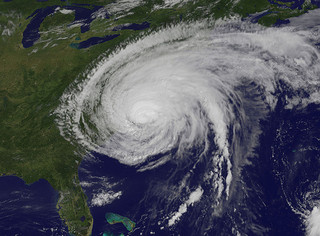Hurricanes
Part i: Introduction; Part ii: Hurricanes in Colonial and Nineteenth-Century North Carolina; Part iii: Twentieth-Century Hurricanes; Part iv: Devastating Hurricanes of the 1990s and Early 2000s
Part I: Introduction
Hurricanes are the most spectacular and destructive weather events experienced in North Carolina. Commonly formed off the coast of Africa over the warm tropical waters of the Atlantic Ocean, embryonic hurricanes drift westward across the ocean, slowly drawing energy and moisture from the warm waters. If the storm continues to gain strength, as is typical when it approaches the Caribbean Basin, winds may exceed 74 miles per hour, the threshold for a hurricane. Hurricanes are divided by size and wind speed into five numerical categories, with a category five hurricane being the most intense. Generally, as hurricanes move away from the warm tropics and into the cooler mid-latitudes, they lose energy so that windspeeds slowly decrease. Consequently, many hurricanes will have passed their peak by the time they reach North Carolina. Also, because hurricanes tend to weaken once they move inland, those coming in from the coast may initially be severe, but may rapidly lose power as they track inland. Nevertheless, a number of category four hurricanes have crossed into North Carolina over the past 100 years, and North Carolinians are well aware of the devastating force and impact that hurricanes have had on the state.
Keep reading > Part II: Hurricanes in Colonial and Nineteenth-Century North Carolina ![]()
Educator Resources:
Teaching Natural Disasters Lesson Plan, State Archives of North Carolina
Reference:
Jay Barnes, North Carolina's Hurricane History (3rd ed., 2001).
Image Credit:
"Hurricane Irene Makes Landfall in North Carolina." Image courtesy of NASA Goddard Space Flight Center. Available from https://www.flickr.com/photos/gsfc/6085588376/ (accessed August 17, 2012).
1 January 2006 | Barefoot, Daniel W.; Battle, Charles; Hegyi, Laura; Robinson, Peter J.
